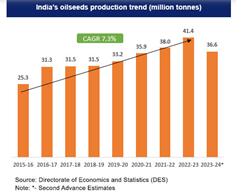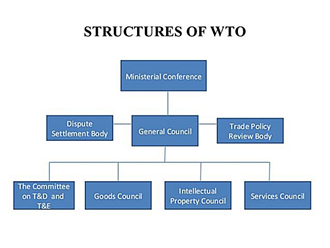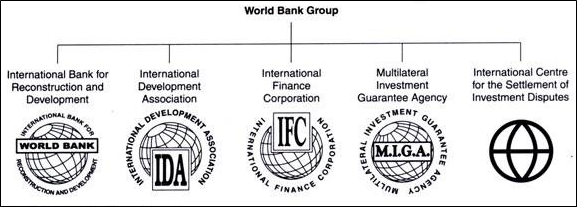It refers to proportion of area under different crops at a given time, changes in this distribution over time and factors determining these changes.
Factors determining cropping pattern of a country
-
- Natural Factors: Nature of soil, type of climate, extent of rainfall etc determine the cropping pattern of a region over a period of time. For example, rice is mainly grown in areas having moderately high rainfall and area which feature water logging like in West Bengal. Similarly, coarse cereals like millets are grown in relatively drier regions like Rajasthan.
- Economic Factors: Prices and accessibility of agricultural inputs, size of land holding and market forces like demand-supply govern the cropping pattern of the region. For example, increased urbanisation pushes the demand of horticultural crops like fruits and vegetables which drives the increased area under cultivation of those crops.
- Historical Factors: Historical pattern of land tenure also plays its role. If there are too many fragmented and small plots of land, the tendency of farmers would be to grow food crops of subsistence nature like cereals. Similarly, larger plots of land pushes farmers for commercial cultivation.
- Government Policies: Subsidies on inputs like fertilisers, pricing policy like minimum support prices (MSP), export policies, agricultural credits are some of the government policies which affect cropping patterns in a significant way. For example, the traditional cotton growing regions of Maharashtra and Gujarat is giving way for coastal states like Tamil Nadu because of availability of institutional credit which are cheap.
- Social Factors: Social customs and traditions govern the dietary pattern of the local population in a significant manner. This, in turn, drives the cultivation and cropping patten of the region. For example, eastern India is predominantly rice consuming which is reflected in the area under cultivation for rice. This is in contrast to the cultivation of wheat in north-western parts of India which have wheat as their staple diet.
Important terms
Total Area: India has a total geographical area of 329 million hectares.
Net Sown Area: It is about 141 million hectares, which is about 43 percent of the total geographical area. The net sown area is defined as the land area which is used for cropped land once a year and is under consideration.
Gross Cropped Area: This represents the total area sown once and/or more than once in a particular year, i.e. the area is counted as many times as there are sowings in year. This total area is also known as total cropped area or total area sown. The total area sown in India is roughly 197 million hectares (mha).
Area under food crops: It constitutes more than 75 percent of total cropped area. In that also, foodgrains constitute more than 130 million hectares of total cropped area or total area sown.
1. Rice
Rice is the most important food crop in India. India is the second largest producer of rice in the world after China. Rice cultivation in India is broadly classified into basmati and non-basmati categories. It is grown over more than 35 percent of area under foodgrains with a total area of more than 46 million hectares. This increase in area has been witnessed in almost every states due to various factors like increased access to high yielding varieties seeds, higher procurement from State agencies etc. In 2022-23, India exported 45.61 lakh tonnes of basmati rice valued at USD 4.79 billion.
The average yield of rice has increased by more than four times in the last seven decades from about 650 kg per hectare in 1950-51 to about more than 2800 kg per hectare in 2021-22. Still, the average yield of rice is only about 70 percent of the potential yield which can be achieved.
Challenges in Rice production
-
- Climate Change: Rice cultivation is sensitive to changes in temperature and precipitation, and farmers may struggle to adapt to a changing climate. The average world temperature is significantly increasing because of global warming, this is causing erratic rainfall pattern which include the frequency and distribution of precipitation patterns.
- Water Management: Rice cultivation requires large amounts of water, and farmers in drought-prone areas can struggle to secure enough water for their crops. Crop yields are strongly affected by weather and water availability.
- Soil Health: The natural microbiome, or microbial ecosystem, of our land, has been destroyed by intensive farming methods, the indiscriminate use of chemical fertilisers, and poor agricultural practices.
- Poor Nutrient Management: A high yield in rice crop production requires sufficient nutrients in the soil. Beneficial microbes in the soil help the plants bio assimilate essential nutrients. But this microbiome gets disturbed due to the overuse of fertilisers. As a result, the rice crop becomes deficient in essential nutrients, leading to poor quality of the crop.
- Pest and Disease Management: Rice crops are susceptible to pests and diseases, which can cause significant yield loss if not properly managed.
2. Wheat
It is the second most important foodgrain crop in India. It occupies about 25 percent of total area under foodgrain production with an estimated size of about 30 million hectares under cultivation. There is an increased production by more than 16 times from only about 6.5 million tonnes in 1950-51 to about 110 million tonnes in 2022-23. This success is largely attributed to the advancement in cultivation technology and strategies adopted during the Green Revolution and systematically getting transmitted to all states of India.
In terms of average yield, there has been significant gains which has increased by more than six times from about 650 kg per hectare to about 3500kg per hectare during the same period.
Challenges in Wheat Production
-
- Climate Change: Wheat is highly temperature-sensitive crop and due to sustained high heat levels particularly warm winters have adverse effects on the production of the wheat crop.
- Cultivation Pattern: Due to monoculture concerns, there is always a concern of outbreak of new disease which may impact cultivation.
- Irrigation facilities: Dwindling supplies of water through irrigation channels is also one of the major concerns since wheat cultivation requires optimum and timely supply of water to the standing crop.
3. Coarse Grains
The total area under cultivation for coarse grains like maize, jowar and bajra have actually declined between 1950-51 and 2021-22 from about 30 percent to about 17 percent. To add to this, the average yield of millets like jowar and bajra have been constant in the above-mentioned period. Moreover, maize cultivation under coarse cereals have been the dominant representation because of food, fodder and fuel uses.
4. Pulses
India is the largest producer, consumer and importer of pulses in the world. Pulses are a source of plant-based protein and other micronutrients. It is grown both in kharif as well as rabi season. Moreover, most of the pulses are from the family of legumes which house many nitrogen fixing bacteria in their root nodes. This is important for restoring the natural fertility and balance of macro nutrients in the soil.
As far as pulses production is concerned, it has stagnated in the last 5 years (2018-2023) whereas demand is consistently increasing, thus India has had to import pulses in large quantities. Pulses constitute roughly 8 percent of total foodgrain production (about 27 million tonnes out of total foodgrain production of 325 million tonnes in 2022-23). In terms of area under cultivation, they constitute about 22-25 percent of total area under cultivation for foodgrains (about 30 million hectares out of 130 million hectares under foodgrains production). Moreover, the productivity of pulses per unit area is very low as compared to that of foodgrains. The Government of India, under PM-AASHA, implements Price Support Scheme (PSS) for pulses and coarse cereals.
Pradhan Mantri Annadata Aay SanraksHan Abhiyan (PM-AASHA)
It is an umbrella scheme to ensure Minimum Support Price (MSP) to farmers.
It comprises the erstwhile Price Support Scheme (PSS) with certain modifications and rolling out of new schemes of Price Deficiency Payment Scheme (PDPS).
Procurement: Oil seeds, pulses and cotton, through NAFED which is the Central nodal agency, at the MSP declared by the government.
Main crops covered: Bajra, Jowar, Maize, Paddy, Cotton, Tur, Moong, Urad, Groundnut, Sesamum Wheat, Gram, Mustard, Sugarcane etc.
What are the Benefits?
Farmers get the benefit through the sale of their produce at minimum support price in APMC centres opened by the Nodal procurement agency.
Under PM-AASHA, States/UTs are offered to choose either PSS and PDPS in a given procurement season with respect to particular oilseeds crop for the entire State.
When prices of commodities fall below the MSP, State and central notified procurement nodal agencies purchase commodities directly from the farmers at MSP to protect the farmers against economic loss in farming.
5. Oil Seeds
India is the fourth largest oilseeds producer in the world. It has 20.8% of the total area under cultivation globally, accounting for 10% of global production. The country produces Groundnut, Soybean, Sunflower, Sesamum, Niger seed, Mustard, And Safflower oilseeds.

Rajasthan, Madhya Pradesh, Gujarat, and Maharashtra were the top producers during 2021-22 with a share of about 23%, 21%, 18% and 16% of the total production, respectively.
India is presently a net importer of edible oil, with 57% of the total edible oil being imported from various countries. The insufficiency in edible oil is negatively impacting our foreign exchange reserves by 20.56 billion USD, making it more important for the nation to become self-sufficient (Atmanirbhar) in the production of edible oil through the promotion of oilseeds and palm oil.
National Mission for Edible Oils – Oil Palm (NMEO-OP)
The Government of India launched the National Mission for Edible Oils – Oil Palm (NMEO-OP) in August 2021. The mission is committed to escalating oil palm cultivation and elevating Crude Palm Oil production to 11.20 lakh tonnes by 2025-26. The scheme is presently operational in 15 states nationwide, covering a potential area of 21.75 lakh hectares.
6. Commercial Crops
-
- Sugarcane: Area under sugarcane has increased from 1.7 mha in 1950-51 to about 5 mha in 2021-22.
- Cotton: It has doubled in the last 70 years since independence to about 12 mha.
- Jute: There has been no increase in jute’s area of cultivation with total area remaining below 1 mha.
Changes in cropping patterns: The Drivers
From an agro-economic perspective, the changes in cropping patterns in India are driven by:
1. Market demand and profitability: High prices and strong demand for cash crops like cotton and sugarcane encourage farmers to shift towards these crops. Input costs and expected market prices also impact profitability.
2. Minimum Support Prices (MSP) and subsidies: Government policies on MSP and subsidies for inputs like fertilizers and irrigation make certain crops more attractive by reducing production costs and guaranteeing returns.
3. Changing consumption patterns: Increasing demand for fruits, vegetables, and high-protein foods due to health consciousness and dietary changes push farmers to diversify into horticulture and high-value crops.
4. Cost of production and technological advancements: Production costs and innovations in farming technology (e.g., high-yielding seeds, precision agriculture) shift cropping patterns towards more profitable and resilient crops.
5. Infrastructure development: Improved storage, transportation, and market access reduce post-harvest losses, making perishable and high-value crops more profitable.
6. Labour dynamics: Labor availability and costs influence crop choices, with mechanized or less labour-intensive crops preferred in regions with labour shortages or high labour costs.
7. Credit availability and risk management: Access to agricultural credit enables investment in high-value crops, while diversification helps manage risks related to climate and market fluctuations.
Spread the Word


